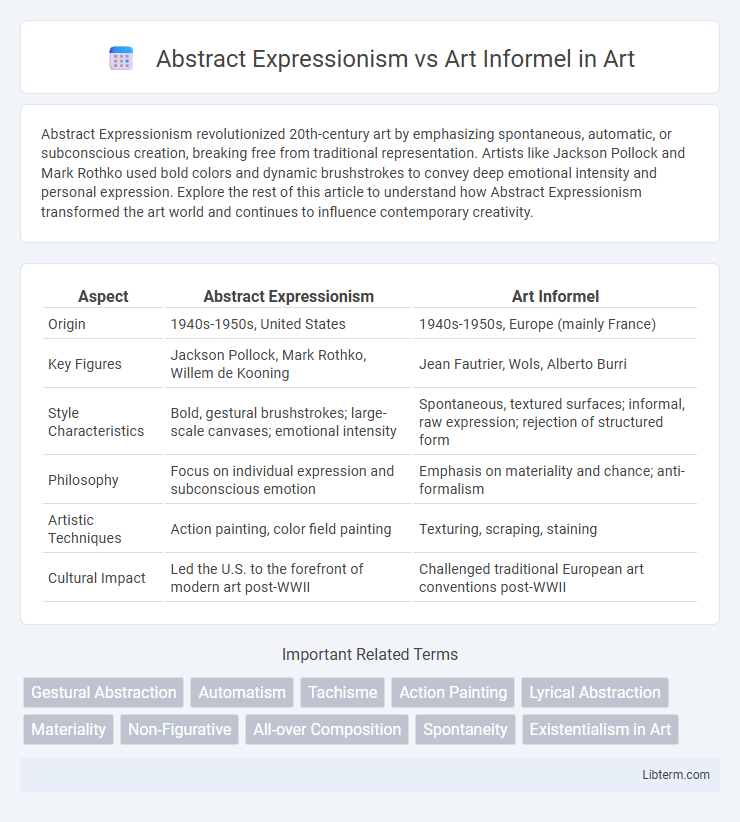Abstract Expressionism revolutionized 20th-century art by emphasizing spontaneous, automatic, or subconscious creation, breaking free from traditional representation. Artists like Jackson Pollock and Mark Rothko used bold colors and dynamic brushstrokes to convey deep emotional intensity and personal expression. Explore the rest of this article to understand how Abstract Expressionism transformed the art world and continues to influence contemporary creativity.
Table of Comparison
| Aspect | Abstract Expressionism | Art Informel |
|---|---|---|
| Origin | 1940s-1950s, United States | 1940s-1950s, Europe (mainly France) |
| Key Figures | Jackson Pollock, Mark Rothko, Willem de Kooning | Jean Fautrier, Wols, Alberto Burri |
| Style Characteristics | Bold, gestural brushstrokes; large-scale canvases; emotional intensity | Spontaneous, textured surfaces; informal, raw expression; rejection of structured form |
| Philosophy | Focus on individual expression and subconscious emotion | Emphasis on materiality and chance; anti-formalism |
| Artistic Techniques | Action painting, color field painting | Texturing, scraping, staining |
| Cultural Impact | Led the U.S. to the forefront of modern art post-WWII | Challenged traditional European art conventions post-WWII |
Introduction to Abstract Expressionism and Art Informel
Abstract Expressionism emerged in the 1940s and 1950s in New York as a movement emphasizing spontaneous, gestural brushstrokes and the artist's emotional intensity, prominently seen in works by Jackson Pollock and Mark Rothko. Art Informel, which developed in Europe during the same period, rejects traditional form and structure, focusing instead on texture, rawness, and the physical act of painting, with artists like Jean Fautrier and Wols leading the movement. Both styles share a focus on abstraction and expressive freedom but differ in geographic origins and specific artistic techniques.
Historical Context and Origins
Abstract Expressionism emerged in the late 1940s in New York City as a response to the trauma of World War II, characterized by spontaneous, gestural brushstrokes and an emphasis on emotional intensity. Art Informel, developing primarily in Europe during the same period, reflected existential disillusionment, favoring abstraction without form and embracing chance and improvisation in reaction to the devastation across the continent. Both movements shared a rejection of traditional representation but diverged in their cultural origins and philosophical underpinnings rooted in post-war realities.
Key Philosophical Foundations
Abstract Expressionism centers on individual emotion and subconscious expression, emphasizing spontaneity and the artist's inner psyche as a source of creativity. Art Informel prioritizes intuition and materiality, rejecting structured composition in favor of improvisation and the physical act of painting. Both movements challenge traditional aesthetics but diverge in their approach to form and the role of the artist's emotional state.
Influential Artists and Pioneers
Abstract Expressionism features influential artists like Jackson Pollock, Mark Rothko, and Willem de Kooning, who pioneered gestural brushwork and emotional intensity in post-World War II American art. Art Informel, emerging in Europe, is represented by artists such as Jean Dubuffet, Wols, and Hans Hartung, emphasizing spontaneity, texture, and the absence of formal structure. Both movements shaped modern art by rejecting traditional techniques and exploring abstraction through individual expression and unconventional materials.
Stylistic Characteristics and Techniques
Abstract Expressionism emphasizes spontaneous, gestural brushstrokes with a focus on emotional intensity and large-scale canvases, often utilizing techniques like action painting and color field. Art Informel rejects formal structure, favoring irregular textures, spontaneity, and raw, organic forms achieved through impasto, scraping, and mixed media. Both styles prioritize abstraction and personal expression but diverge in their approach to composition and surface treatment.
Approach to Gesture and Spontaneity
Abstract Expressionism emphasizes vigorous, large-scale gestures with an intense focus on individual expression and emotional spontaneity, often reflecting the artist's psyche through dynamic brushwork. Art Informel prioritizes an unstructured, improvisational approach, highlighting raw materiality and chance effects to convey a sense of unpredictability and organic formation. Both movements value spontaneity, but Abstract Expressionism centers on deliberate, theatrical gesture, while Art Informel embraces uncontrolled, process-driven creation.
Cultural and Geographical Influences
Abstract Expressionism emerged in post-World War II New York, heavily influenced by American ideals of individualism and existential freedom, reflecting a cultural shift towards personal expression within a rapidly modernizing society. Art Informel developed in Europe, particularly France, shaped by the trauma of war and a desire to break from traditional artistic conventions, emphasizing spontaneous, subconscious creation tied to European existential philosophy. Geographically, Abstract Expressionism's urban American context fostered large-scale canvases and bold gestures, while Art Informel's connection to European art centers encouraged introspective textures and informal compositions.
Impact on Contemporary Art Movements
Abstract Expressionism, characterized by its emphasis on spontaneous, gestural brushstrokes and emotional intensity, significantly influenced the development of action painting and later movements such as Neo-Expressionism. Art Informel, with its focus on texture, materiality, and non-geometric abstraction, played a crucial role in shaping European post-war art, inspiring movements like Tachisme and Lyrical Abstraction. Both movements challenged traditional artistic conventions and paved the way for contemporary art's emphasis on individual expression and experimental forms.
Critical Reception and Legacy
Abstract Expressionism received widespread acclaim for its emotional intensity and innovative techniques, solidifying its status as a pivotal movement in post-war American art. Art Informel, although less commercially successful, gained critical recognition in Europe for its spontaneity and rejection of traditional form, influencing avant-garde circles. Both movements significantly shaped modern art by challenging conventions and expanding the boundaries of abstract expression through distinct cultural and philosophical lenses.
Conclusion: Lasting Significance and Differences
Abstract Expressionism emphasizes spontaneous, emotional brushwork and large-scale canvases, while Art Informel prioritizes texture, materiality, and improvisation without strict composition. Both movements profoundly influenced post-war art by rejecting traditional forms and embracing individual expression, yet Abstract Expressionism remains more recognized globally for its bold, gestural style. Their lasting significance lies in advancing modern art's exploration of subconscious expression and redefining artistic freedom through distinct but complementary approaches.
Abstract Expressionism Infographic

 libterm.com
libterm.com